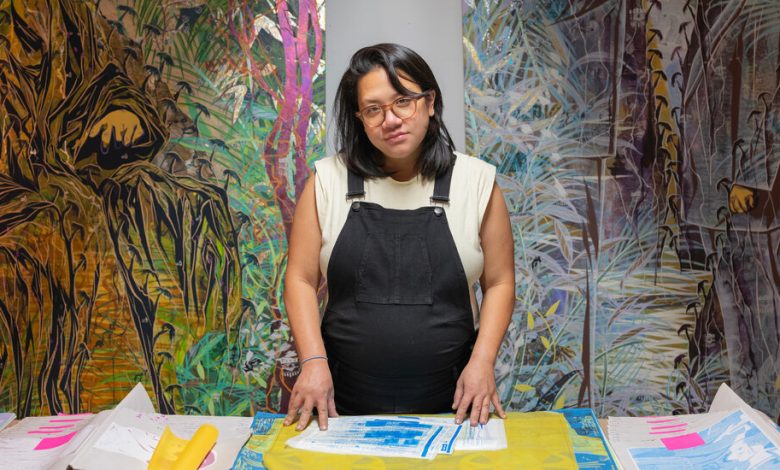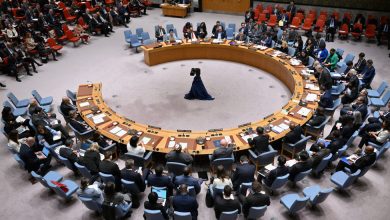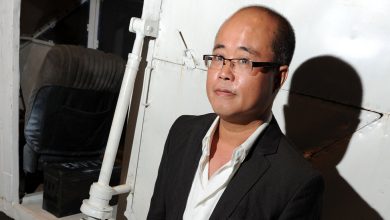Tammy Nguyen, Maximalist at Play

The artist Tammy Nguyen was visiting a small island in Indonesia a few years back, when she came across the Jesus statues.
There were 14 of them, decaying in the jungle on Galang Island, the site of a camp for refugees who fled Vietnam by boat — at great peril — after the Communist victory in 1975. Nguyen’s parents had transited there before she was born. It was not a subject they brought up.
The camp, she realized, had been a large settlement with dwellings, schools and other facilities. But it was the statues of Jesus on the Stations of the Cross that got her thinking. They communicated so much history — how the French brought Roman Catholicism to Vietnam; how the war and its aftermath upended lives and scattered refugees — and how Nature had the last word, overwhelming them in vegetation.
For the 2022 Berlin Biennale, Nguyen made a 14-painting suite inspired by this experience. Each presented one of the Stations of the Cross, though with the figures stylized, blurred by grasses and fronds, surrounded by birds or animals — and also references to the Vietnam War era, such as a Pan American jetliner and tiny recurring gold-leaf helicopters.
Nguyen, 40, is a kind of maximalist, one driven by questions, not certainties. “I mythologize and make grandiose history that I can’t understand,” she said, in her barn-studio in Easton, Conn. “I’m excited by smashing different moments in time together, different threads in history, and making them more confusing, more ambiguous.”
Her methods are equally layered. A maker of handcrafted books, she draws on those techniques for her paintings. Composed on laminated paper stretched onto board, they involve watercolors, vinyl paint, pastel, screen printing, rubber stamps and gilding.
The result is an idiosyncratic subgenre, at the borders of painting and book arts; political and natural history; research and intuition. The aim for each picture, she said, is a “fluid spiritual world” open to interpretation.
The work is striking a chord. A breakout solo show at Smack Mellon, in Brooklyn, in 2021, drew on a huge real-estate venture near Singapore that failed to take off. Later in 2021 Nguyen appeared in the Greater New York quinquennial at MoMA PS1.
Her first museum solo show is ongoing at the Institute of Contemporary Art in Boston (through Jan. 28). Here, in paintings themed for the four seasons, the main characters who melt into vegetation include Ralph Waldo Emerson, craggy and patrician as in his statue in Concord, Mass.; the Greek goddess Demeter; Ngo Đình Diem, the president of South Vietnam from 1955 until his assassination in 1963; and Jesus again, this time after a huge statue in Vũng Tàu, Vietnam.
But approach the paintings — or peruse the artist books Nguyen produced for the exhibition — and the layers reveal, among other things, excerpts from Emerson’s 1836 essay “On Nature” and facsimiles of archival documents on land reform in South Vietnam.
It’s a lot to take in, but that’s also the point. With their lavish botanical atmosphere, Nguyen’s paintings elaborate on a classic theme — Man vs. Nature. In detail, they suggest that history is cacophonous, full of unintended consequences, ripe for unorthodox connections.
“They hold in a kind of suspension the complexity of history,” Jeffrey De Blois, associate curator at the ICA, said of this intuitive, juxtapositional approach in Nguyen’s paintings. He added, “She’s interested in making a kind of poetics from history and from the archive.”
The ICA show offers a case in point. When invited, Nguyen said, she had just finished “Emerson’s ‘Nature’ and the Artists,” a 2021 book by the historian and critic Tyler Green. It traces the influence of Emerson’s distinctive usage of “landscape” as a form of natural beauty that enfolds the human presence, including villages and farms — a conception both idealistic and blinkered, overriding the Indigenous presence and its conceptions of the land.
Emerson, Nguyen thought, would make a good anchor for a Boston show. But the topic prompted a digression as well. The U.S.-backed land reform programs in South Vietnam, at various points in the Vietnam War, never succeeded. Could one imagine a link back to Emerson’s philosophy, at least artistically?
It was enough to send her digging into the National Archives, scanning obscure files pertaining to land reform and U.S. aid to Vietnam. Layered into the paintings and book pages are bureaucratic documents, for instance budgets tallying bicycles or typewriters requested to run the program.
Three administrators, shown but not named in a file photograph, become recurring secondary figures in the paintings. “I’ve always been excited by the challenge of creating poetry out of policy documents,” Nguyen said. “That seems like such a huge leap.”
Yes, she’s a nerd. Growing up in Daly City, Calif., Nguyen attended music school on Saturdays and Vietnamese school on Sundays. “I was in school all the time,” she said.
A high-school class in theater tech showed her how to build and paint at large scale. A teacher there told her about the Cooper Union. It was a leap: “I’d never been to New York,” she said. “Was it a real school?” But enrolling there proved thrilling. “I was a muscular abstract painter,” she said. Her inspirations included Amy Sillman and Charlene von Heyl.
Still, Nguyen said, “there was a hole in my heart and my brain that I just needed to fill.” Although her family socialized with Vietnamese friends, they had consigned the country itself to their past — whereas she was ready to encounter it on her own terms.
Traveling to Vietnam on a Fulbright fellowship, she enrolled in a Ho Chi Minh City art school in 2007, discovering a different atmosphere. “We’d make lacquer paintings, someone would go to the market and bring back a fish, we’d fry it in the classroom,” she said. In town, local and diasporic artists were starting cultural spaces like Sàn Art. “I knew the city,” Nguyen said of Saigon (as she, like many residents, still calls the city). “I rode my motorbike like a maniac. It was fun.”
She worked as an assistant to artists (including the multimedia artist Tuan Andrew Nguyen) and later for a ceramic tile company. On a business trip to China, she experienced the vertiginous scale of modern factory floors. “It had a Mordor quality but was also awe-striking,” she said.
Returning to the U.S., Nguyen enrolled at Yale for her M.F.A. There, she found that abstract painting, once a protection from making work about her identity, had become an awkward container for her new questions —about power, empire, religion, economics. To explore them, she wanted to bring figuration into her work but couldn’t shake her inhibitions.
The solution would come from an unusual place. Interning at Yale’s ornithology lab, she learned taxidermy and sketched what she saw. “I learned to skin birds to help scientists study feather distribution or whatever,” she said, “and I brought my watercolors and started drawing.”
As busy as Nguyen’s paintings can be, they are legible, even concise, in the way a line can contribute at once to a figure, background or ornamentation. (East Asian landscape painting, with its economy, is another inspiration, she said.) And for all the layers involved in making her paintings, the final picture surface is remarkably integrated. “I wanted to find a way to make it seem like my images were coming from within the panel,” she said.
For De Blois, the ICA curator, Nguyen’s “material expertise” is a hallmark of her paintings. “She operates with a kind of specialized knowledge that would have belonged in yesteryear to members of a guild,” he said. The craft shows in the artist books that Nguyen has produced for a decade — at first, elaborate hand-bound ones; more recently, limited editions that she distributes through her publishing project, Passenger Pigeon Press.
These often involve collaborations — with poets, scientists, photographers — or incorporate texts that are in the public domain. One recent volume, “Atomic Sublime,” examines nuclear weapon development in the American Southwest, with art by Nguyen and essays by Lovely Umayam, a writer and nonproliferation expert.
Now, Nguyen is making work for upcoming shows at the Lehmann Maupin gallery, each referring to a volume in Dante’s “Divine Comedy”: “Purgatory” in London in March 2024 and “Paradise” in New York in 2025. (She dealt with “Inferno” at the Seoul location earlier this year.) Dante and Virgil appear, but of course Nguyen’s interpretation contains much more. Where Dante depicts Purgatory as a mountain, for instance, Nguyen imagines a gold-mining expedition.
By this point, she said, her web of associations — from mining in Southeast Asia to 1970s geopolitics to the refugee camp — has become a method of self-discovery.
It’s her way of understanding herself in the face of history’s big forces. “All these connections humanize policy for me, and situate me in this greater world,” she said. “This process has led me to a place that’s intimate and that I’m excited to share.”



